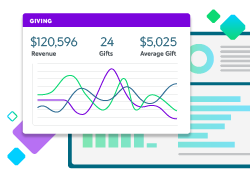Using Data to Make Annual Giving Work for You

Annual giving folk are a strange breed. I know because I’m one of them.
We aren’t tempted by the glamour and glitz of major gifts, the gold-lettered names on a wall or building. No, we prefer to build relationships en masse, using data-driven insights to tell us what our donors really want.
But, what if you’re the kind of fundraiser who is expected to complete your annual giving program “off the side of your desk,” with no fancy agency to guide you on the latest trends, no idea what your donors really respond to, no current data segmentation strategy to contend with? You might even have another job to do in its entirety.
I want to let you know that this is okay!
Annual giving is a long game, requiring patience to get a return on investment. I want you to have the confidence (and your leadership team to have the confidence in you) that with data and time, you can make annual giving work for your organization.
Here is my three-step plan to help you get to baseline with your annual giving program:
1. Plan for your year.
While it’s important to be nimble, it’s equally important to have a well-thought-out strategy. Create a data-based plan for your donors that determines who your segments will be and which segments will receive which touchpoints. For example:
| Donor Type | Mailing 1 | Newsletter | Mailing 2 |
| Annual Donors ($5–$500) | X | X | X |
| Leadership Donors ($501–$10K) | X | X | |
| Monthly Donors (recurring gifts > $5/month) | X |
If you have good historical data to look back on, do that, and determine what your donor base is expecting from you. Do your monthly donors expect your newsletter? Be sure to send it to them to avoid hundreds of calls asking, “Where is it?” Do your major donors like to be included in your end-of-year solicitation? No? Keep them out of it for now (we can always test that later.)
Tip: Using the Giving Analysis for Appeals report in Blackbaud Raiser’s Edge NXT® is a great first step to analyzing your historical data.
2. Segment your data, but don’t OVER-segment.
According to Teemu Raitaluoto, CEO at markettailor.io, you should attempt to strike the right balance between segmentation and simplification.
“While creating more segments may seem like a way to better target [donors],” he explains, “over-segmentation can lead to overly complex campaigns that do not resonate with [them].”
When over-segmentation occurs, it often leads to small sample sizes within each segment, which makes it harder to get statistically significant results and draw reliable conclusions. When segment sizes are too small, the data becomes prone to random variations and fluctuations, making it difficult to distinguish meaningful patterns or trends from the noise. This could weaken the validity and credibility of any insights you may have derived, making the exercise moot.
A general rule of thumb is that 100 responses per segment are required for the results to be statistically significant. If you are expecting an 8% response rate from your donors, that means the segment needs to include at least 1,250 constituents. In this case of a (very) high response rate, if you have a small database of 5,000 constituents to whom you’re mailing, that will mean you would not want to segment them into more than four segments.
You will want to keep track of those segments in your fundraising CRM. While using constituent codes to denote the segments your donors are in is an option, it leaves the onus on you to update these as your donors move up and down segments. Using a CRM that has dynamic constituent lists will save you time and effort.
Tip: If using Blackbaud Raiser’s Edge NXT, be sure to apply the appropriate appeal records and package codes to your constituent lists for good record keeping. Package codes will determine the segment and where in the A/B test they fall—see more in step three, below.
3. Test one thing at a time.
The only way you’ll ever know what’s working and what’s not is by testing your approach. But you don’t want to take the kitchen sink approach, testing absolutely everything at once. Similar to over-segmentation, testing too many variables means the nuance of each one could be lost. For each touchpoint, test one aspect in an A/B style, and then use that as your winner for future communications.
Here are some examples of what you can and should test:
- Outer envelope: full color and branding vs. corporate standard envelope
- Ask: hard ask vs. soft ask
- For acquisitions: premium vs. no premium
- Impact report: insert vs. no insert
Tip: If you use Raiser’s Edge NXT, be sure to note in your package codes which part of the A/B test your donor fell into.
_____________
There is a lot of pressure on annual giving programs to perform, and understandably so. Most organizations are not flush with excess cash and need to raise as much as they can to fund their programs and operations. But it’s also important to remember that the outcome of a good annual giving program is to create the pipeline for monthly, leadership, planned, and major giving donors. Getting good insights on your donors’ wants, needs, and likes is more important than a fast influx of cash that gives you no reliable data regarding why it worked (and how to repeat that success).
Use your fundraising CRM as your source of truth, with clearly defined processes and coding procedures. Clean data + good reporting + a thought-out annual giving program = your life, a little bit easier!
The Nonprofit CRM Built for Fundraisers
Find out how Blackbaud’s Raiser’s Edge NXT® fits your organization.

